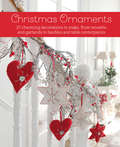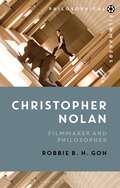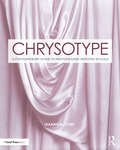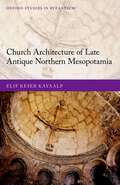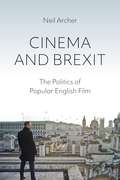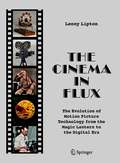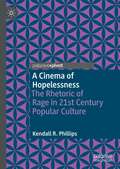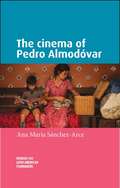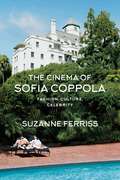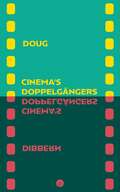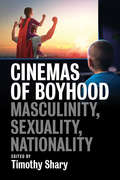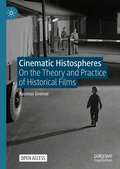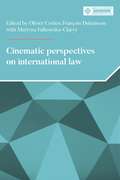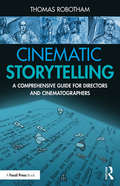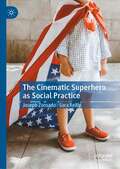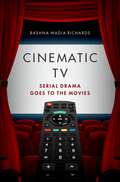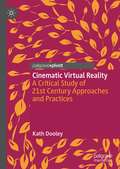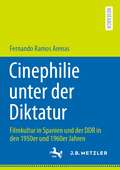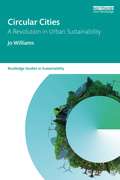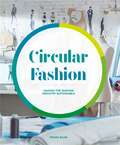- Table View
- List View
Christmas Ornaments
by CICO Books27 charming decorations to make, from wreaths and garlands to baubles and table centerpieces
Christopher Nolan: Filmmaker and Philosopher (Philosophical Filmmakers)
by Robbie B. GohChristopher Nolan is the writer and director of Hollywood blockbusters like The Dark Knight and The Dark Knight Rises, and also of arthouse films like Memento and Inception. Underlying his staggering commercial success however, is a darker sensibility that questions the veracity of human knowledge, the allure of appearance over reality and the latent disorder in contemporary society. This appreciation of the sinister owes a huge debt to philosophy and especially modern thinkers like Friedrich Nietzsche, Sigmund Freud and Jacques Derrida. Taking a thematic approach to Nolan's oeuvre, Robbie Goh examines how the director's postmodern inclinations manifest themselves in non-linearity, causal agnosticism, the threat of social anarchy and the frequent use of the mise en abyme, while running counter to these are narratives of heroism, moral responsibility and the dignity of human choice. For Goh, Nolan is a 'reluctant postmodernist'. His films reflect the cynicism of the modern world, but with their representation of heroic moral triumphs, they also resist it.
Chrysotype: A Contemporary Guide to Photographic Printing in Gold (Contemporary Practices in Alternative Process Photography)
by Leanne McPheeChrysotype is about photographic printing in gold on paper. This 19th century printing process, modified for contemporary use, provides artists with an affordable way to produce permanent prints in gold. By using film or digital negatives, striking hand-coated prints can be created in monochromatic hues ranging from pink, violet, magenta and purple, to green, blue, grey and black. Chrysotype offers a how-to guide for intermediate practitioners with illustrated examples and simple explanations for each stage of the chrysotype process. The book is divided into three sections: history; preparation and how-to; and the work of contemporary artists using chrysotype. This book includes: A concise account of the invention and modification of the chrysotype process, including early discoveries about gold and colour and the significance of moisture for printing in gold How to set up your workspace for printing, including useful equipment and materials Advice on safe chemical practice A step-by-step guide to creating suitable digital and film negatives Guidance on paper selection and how to successfully coat paper An overview guide to creating a chrysotype print Step-by step directions for creating the chrysotype solutions An explanation of mixing ratios and solution volumes that control contrast An illustrated explanation of the effect of humidity on colour, including split tone colours and ways to control humidity Step-by-step directions on post-exposure hydration to lengthen tonal range and lower contrast Step-by-step tray processing directions Advanced techniques such as handling translucent papers, additional chrysotype formulas and procedures, and alternative developing agents that support longer development, colour formation and remedy problems that affect image quality Troubleshooting chrysotype printing, including advice and photographic examples Illustrated profiles of contemporary artists making chrysotype prints, including their methods and tips Chrysotype serves to inform, encourage and challenge a new generation of alternate process practitioners and a growing chrysotype community, from the newly curious to the experienced professional.
Chrysotype: A Contemporary Guide to Photographic Printing in Gold (Contemporary Practices in Alternative Process Photography)
by Leanne McPheeChrysotype is about photographic printing in gold on paper. This 19th century printing process, modified for contemporary use, provides artists with an affordable way to produce permanent prints in gold. By using film or digital negatives, striking hand-coated prints can be created in monochromatic hues ranging from pink, violet, magenta and purple, to green, blue, grey and black. Chrysotype offers a how-to guide for intermediate practitioners with illustrated examples and simple explanations for each stage of the chrysotype process. The book is divided into three sections: history; preparation and how-to; and the work of contemporary artists using chrysotype. This book includes: A concise account of the invention and modification of the chrysotype process, including early discoveries about gold and colour and the significance of moisture for printing in gold How to set up your workspace for printing, including useful equipment and materials Advice on safe chemical practice A step-by-step guide to creating suitable digital and film negatives Guidance on paper selection and how to successfully coat paper An overview guide to creating a chrysotype print Step-by step directions for creating the chrysotype solutions An explanation of mixing ratios and solution volumes that control contrast An illustrated explanation of the effect of humidity on colour, including split tone colours and ways to control humidity Step-by-step directions on post-exposure hydration to lengthen tonal range and lower contrast Step-by-step tray processing directions Advanced techniques such as handling translucent papers, additional chrysotype formulas and procedures, and alternative developing agents that support longer development, colour formation and remedy problems that affect image quality Troubleshooting chrysotype printing, including advice and photographic examples Illustrated profiles of contemporary artists making chrysotype prints, including their methods and tips Chrysotype serves to inform, encourage and challenge a new generation of alternate process practitioners and a growing chrysotype community, from the newly curious to the experienced professional.
Church Architecture of Late Antique Northern Mesopotamia (Oxford Studies in Byzantium)
by Elif Keser KayaalpChurch Architecture of Late Antique Northern Mesopotamia examines the church architecture of Northern Mesopotamia between the fourth and eighth centuries. Keser Kayaalp focuses on settlements, plan types, artistic encounters, the remarkable continuity of the classical tradition in the architectural decoration, the heterogeneity of the building techniques, patrons, imperial motivations, dedications of churches, and stories that claim and make spaces. Employing archaeological and epigraphical material and hagiographical and historical sources, she presents a holistic picture of the church architecture of this frontier region, encompassing the cities of Nisibis (Nusaybin), Edessa (Şanliurfa), Amida (Diyarbakir), Anastasiopolis (Dara/Oğuz), Martyropolis (Silvan), Constantia (Viranşehir), and their surroundings, and the rural Tur Abdin region. The period covered spans the last centuries of Byzantine and the first century and a half of Arab rule, when the region was, on the one hand, a stage of war and riven by religious controversies, and a cultural interspace on the other. Keser Kayaalp discusses the different dynamics in this frontier region and the resulting built environment and church architecture in pursuit of providing a regional contribution to the study of the transformation that the Byzantine civilization underwent in the late antique period and understanding the continuities and changes after the Arab conquest.
Cinema and Brexit: The Politics of Popular English Film (Cinema and Society)
by Neil ArcherNeil Archer's original study makes a timely and politically-engaged intervention in debates about national cinema and national identity. Structured around key examples of 'culturally English cinema' in the years up to and following the UK's 2016 vote to leave the European Union, Cinema and Brexit looks to make sense of the peculiarities and paradoxes marking this era of filmmaking. At the same time as providing a contextual and analytical reading of 21st century filmmaking in Britain, Archer raises critical questions about popular national cinema, and how Brexit has cast both light and shadow over this body of films.Central to Archer's argument is the idea that Brexit represents not just a critical moment in how we will understand future film production, but also in how we will understand production of the recent past. Using as a point of departure the London Olympics opening ceremony of 2012, Cinema and Brexit considers the tensions inherent in a wide range of films, including Skyfall (2012), Dunkirk (2017), Their Finest (2017), Darkest Hour (2017), The Crown (Netflix, 2016), Paddington (2014), Paddington 2 (2017), Never Let Me Go (2011), Absolutely Fabulous: The Movie (2016), The Trip (2010), The Inbetweeners Movie (2011), Mr. Bean's Holiday (2007), The World's End (2013), Sightseers (2012), One Day (2011), Attack the Block (2011), King Arthur: Legend of the Sword (2017) and The Kid Who Would be King (2019). Archer examines the complex national narratives and representations these films expound, situating his analyses within the broader commercial contexts of film production beyond Hollywood, highlighting the negotiations or contradictions at play between the industrial imperatives of contemporary films and the varied circumstances in which they are made. Considering some of the ways a popular and globally-minded English cinema is finding means to work alongside and through the contexts of Brexit, he questions what are the stakes for, and possibilities of, a global 'culturally English cinema' in 2019 and beyond.
The Cinema in Flux: The Evolution of Motion Picture Technology from the Magic Lantern to the Digital Era
by Lenny LiptonThe first of its kind, this book traces the evolution of motion picture technology in its entirety. Beginning with Huygens' magic lantern and ending in the current electronic era, it explains cinema’s scientific foundations and the development of parallel enabling technologies alongside the lives of the innovators. Product development issues, business and marketplace factors, the interaction of aesthetic and technological demands, and the patent system all play key roles in the tale. The topics are covered sequentially, with detailed discussion of the transition from the magic lantern to Edison’s invention of the 35mm camera, the development of the celluloid cinema, and the transition from celluloid to digital. Unique and essential reading from a lifetime innovator in the field of cinema technology, this engaging and well-illustrated book will appeal to anyone interested in the history and science of cinema, from movie buffs to academics and members of the motion picture industry.
A Cinema of Hopelessness: The Rhetoric of Rage in 21st Century Popular Culture (Rhetoric, Politics and Society)
by Kendall R. PhillipsThis book explores the circulation of anger and hostility in contemporary American culture with particular attention to the fantasy of refusal, a dream of rejecting all the structures of the contemporary political and economic system. Framing the question of public sentiment through the lens of rhetorical studies, this book traces the circulation of symbols that craft public feelings in contemporary popular cinema. Analyzing popular twenty-first century films as invitations to a particular way of feeling, the book delves into the way popular sentiments are circulated and intensified. The book examines dystopian films (The Purge, The Cabin in the Woods), science fiction (Snowpiercer), and superhero narratives (the Marvel Cinematic Universe and Joker). Across these varied films, an affective economy that emphasizes grief, betrayal, refusal, and an underlying rage at the seeming hopelessness of contemporary culture is uncovered. These examinations are framed in terms of ongoing political protests ranging from Occupy Wall Street, the Tea Party, Black Lives Matter, and the 6th January 2021 invasion of the US Capitol Building.
The cinema of Pedro Almodóvar (Spanish and Latin-American Filmmakers)
by Ana María Sanchez-ArceThis book offers a comprehensive film-by-film analysis of Spain’s most famous living director, Pedro Almodóvar. It shows how Almodóvar's films draw on various national cinemas and genres, including Spanish cinema of the dictatorship, European art cinema, Hollywood melodrama and film noir. It also argues that Almodóvar's work is a form of social critique, his films consistently engaging with and challenging stereotypes about traditional and contemporary Spain in order to address Spain's traumatic historical past and how it continues to inform the present. Drawing on scholarship in both English and Spanish, the book will be of interest to undergraduate and postgraduate students of film studies and Hispanic studies, scholars of contemporary cinema and general readers with a passion for the films of Pedro Almodóvar.
The cinema of Pedro Almodóvar (Spanish and Latin-American Filmmakers)
by Ana María Sanchez-ArceThis book offers a comprehensive film-by-film analysis of Spain’s most famous living director, Pedro Almodóvar. It shows how Almodóvar's films draw on various national cinemas and genres, including Spanish cinema of the dictatorship, European art cinema, Hollywood melodrama and film noir. It also argues that Almodóvar's work is a form of social critique, his films consistently engaging with and challenging stereotypes about traditional and contemporary Spain in order to address Spain's traumatic historical past and how it continues to inform the present. Drawing on scholarship in both English and Spanish, the book will be of interest to undergraduate and postgraduate students of film studies and Hispanic studies, scholars of contemporary cinema and general readers with a passion for the films of Pedro Almodóvar.
The Cinema of Sofia Coppola: Fashion, Culture, Celebrity
by Suzanne FerrissThe Cinema of Sofia Coppola provides the first comprehensive analysis of Coppola's oeuvre that situates her work broadly in relation to contemporary artistic, social and cultural currents. Suzanne Ferriss considers the central role of fashion - in its various manifestations - to Coppola's films, exploring fashion's primacy in every cinematic dimension: in film narrative; production, costume and sound design; cinematography; marketing, distribution and auteur branding. She also explores the theme of celebrity, including Coppola's own director-star persona, and argues that Coppola's auteur status rests on an original and distinct visual style, derived from the filmmaker's complex engagement with photography and painting.Ferriss analyzes each of Coppola's six films, categorizing them in two groups: films where fashion commands attention (Marie Antoinette, The Beguiled and The Bling Ring) and those where clothing and material goods do not stand out ostentatiously, but are essential in establishing characters' identities and relationships (The Virgin Suicides, Lost in Translation and Somewhere). Throughout, Ferriss draws on approaches from scholarship on fashion, film, visual culture, art history, celebrity and material culture to capture the complexities of Coppola's engagement with fashion, culture and celebrity. The Cinema of Sofia Coppola is beautifully illustrated with color images from her films, as well as artworks and advertising artefacts.
Cinema's Doppelgängers
by Doug DibbernCinema’s Doppelgängers is a counterfactual history of the cinema – or, perhaps, a work of speculative fiction in the guise of a scholarly history of film and movie guide. That is, it’s a history of the movies written from an alternative unfolding of historical time – a world in which neither the Bolsheviks nor the Nazis came to power, and thus a world in which Sergei Eisenstein never made movies and German filmmakers like Fritz Lang never fled to Hollywood, a world in which the talkies were invented in 1936 rather than 1927, in which the French New Wave critics didn’t become filmmakers, and in which Hitchcock never came to Hollywood. The book attempts, on the one hand, to explore and expand upon the intrinsically creative nature of all historical writing; like all works of fiction, its ultimate goal is to be a work of art in and of itself. But it also aims, on the other hand, to be a legitimate examination of the relationship between the economic and political organization of nations and film industries and the resulting aesthetics of film and thus of the dominant ideas and values of film scholarship and criticism.
Cinemas of Boyhood: Masculinity, Sexuality, Nationality
by Timothy SharyDrawing from political sociology, pop psychology, and film studies, Cinemas of Boyhood explores the important yet often overlooked subject of boys and boyhood in film. This collected volume features an eclectic range of films from British and Indian cinemas to silent Hollywood and the new Hollywood of the 1980s, culminating in a comprehensive overview of the diverse concerns surrounding representations of boyhood in film.
Cinematic Histospheres: On the Theory and Practice of Historical Films
by Rasmus GreinerIn this Open Access book, film scholar Rasmus Greiner develops a theoretical model for the concept of the histosphere to refer to the “sphere” of a cinematically modelled, physically experienceable historical world. His analysis of practices of modelling and perceiving, immersion and empathy, experience and remembering, appropriation and refiguration, combine approaches from film studies, such as Vivian Sobchack’s phenomenology of film experience, with historiographic theories, such as Frank R. Ankersmit’s concept of historical experience. Building on this analysis, Greiner examines the spatial and temporal organization of historical films and presents discussions of mood and atmosphere, body and memory, and genre and historical consciousness. The analysis is based around three historical films, spanning six decades, that depict 1950s Germany: Helmut Käutner’s Sky Without Stars (1955), Jutta Brückner’s Years of Hunger (1980), and Sven Bohse’s three-part TV series Ku’damm 56 (2016).
Cinematic perspectives on international law (Melland Schill Perspectives on International Law)
by Sufyan DroubiThe proposed volume consists of an edited collection within the new Melland Schill Guidebooks on International Law (MSGIL) series. In line with the MSGIL objective of inclusiveness, originality, perspectivism and critical thought, the book is the first of an intended series pertaining to perspectives related to the ways in which the arts influence the perception and attitude of the public towards international law, and the manner this affects the discipline, both in terms of its own development and in terms of its social legitimacy. The book contrasts the narratives of international law depicted in cinema and TV productions with the corresponding narratives advanced by legal scholars. It identifies a cognitive dissonance between them and ascertains its implications on general perceptions of international law.
Cinematic perspectives on international law (Melland Schill Perspectives on International Law)
by Sufyan DroubiThe proposed volume consists of an edited collection within the new Melland Schill Guidebooks on International Law (MSGIL) series. In line with the MSGIL objective of inclusiveness, originality, perspectivism and critical thought, the book is the first of an intended series pertaining to perspectives related to the ways in which the arts influence the perception and attitude of the public towards international law, and the manner this affects the discipline, both in terms of its own development and in terms of its social legitimacy. The book contrasts the narratives of international law depicted in cinema and TV productions with the corresponding narratives advanced by legal scholars. It identifies a cognitive dissonance between them and ascertains its implications on general perceptions of international law.
Cinematic Storytelling: A Comprehensive Guide for Directors and Cinematographers
by Thomas RobothamThis book presents a new, story-based approach to cinematic coverage and storytelling in film and video. It breaks from the conventional idea that shots are the fundamental unit of filmmaking, instead exploring the specifics of determining coverage. Keyframes in patterns are introduced, delivering scripted material in a context-rich presentation that supports the storytelling. All the analysis, interpretation, and creative decision making is done first, with shots derived as the very last step. Scripted material is divided into six categories with associated patterns. Like cinematic building blocks, these can freely stack up and interconnect, supporting creativity and avoiding rigid formulas. This approach enables filmmakers to tap into the film "language" that audiences already understand and put it to practical use, helping the audience to feel the storytelling deeply. Dozens of film examples are provided throughout, plus conceptual and camera diagrams to contextualize the methods presented, and exercises are provided to reinforce concepts. Emphasis is placed on supporting performance and story meaning through a cinematic context. With all the concepts and decision-making options described and shown in examples, a scripted scene is analyzed and developed through an eight-step process, illustrated with storyboard, camera diagrams, and ultimately shot list descriptions. The book is ideal for filmmaking students interested in directing and cinematography, as well as aspiring and early-career filmmakers, cinematographers, and directors.
Cinematic Storytelling: A Comprehensive Guide for Directors and Cinematographers
by Thomas RobothamThis book presents a new, story-based approach to cinematic coverage and storytelling in film and video. It breaks from the conventional idea that shots are the fundamental unit of filmmaking, instead exploring the specifics of determining coverage. Keyframes in patterns are introduced, delivering scripted material in a context-rich presentation that supports the storytelling. All the analysis, interpretation, and creative decision making is done first, with shots derived as the very last step. Scripted material is divided into six categories with associated patterns. Like cinematic building blocks, these can freely stack up and interconnect, supporting creativity and avoiding rigid formulas. This approach enables filmmakers to tap into the film "language" that audiences already understand and put it to practical use, helping the audience to feel the storytelling deeply. Dozens of film examples are provided throughout, plus conceptual and camera diagrams to contextualize the methods presented, and exercises are provided to reinforce concepts. Emphasis is placed on supporting performance and story meaning through a cinematic context. With all the concepts and decision-making options described and shown in examples, a scripted scene is analyzed and developed through an eight-step process, illustrated with storyboard, camera diagrams, and ultimately shot list descriptions. The book is ideal for filmmaking students interested in directing and cinematography, as well as aspiring and early-career filmmakers, cinematographers, and directors.
The Cinematic Superhero as Social Practice
by Joseph Zornado Sara ReillyThis book analyzes the cinematic superhero as social practice. The study’s critical context brings together psychoanalysis and restorative and reflective nostalgia as a way of understanding the ideological function of superhero fantasy. It explores the origins of cinematic superhero fantasy from antecedents in myth and religion, to twentieth-century comic book, to the cinematic breakthrough with Superman (1978). The authors then focus on Spider-Man as reflective response to Superman’s restorative nostalgia, and read MCU’s overarching narrative from Iron Man to End Game in terms of the concurrent social, political, and environmental conditions as a world in crisis. Zornado and Reilly take up Wonder Woman and Black Panther as self-conscious attempts to reflect on gender and race in restorative superhero fantasy, and explore Christopher Nolan’s Dark Knight trilogy as a meditation on the need for authoritarian fascism. The book concludes with Logan, Wonder Woman 1984, and Amazon Prime’s The Boys as distinctly reflective fantasy narratives critical of the superhero fantasy phenomenon.
Cinematic TV: Serial Drama goes to the Movies
by Rashna Wadia RichardsFor decades after its invention, television was considered by many to be culturally deficient when compared to cinema, as analyses rooted in communication studies and the social sciences tended to focus primarily on television's negative impact on consumers. More recently, however, denigration has largely been replaced by serious critical consideration of what television represents in the post-network era. Once derided as a media wasteland, TV is now praised for its visual density and complexity. In the last two decades, media scholars have often suggested that television has become cinematic. Serial dramas, in particular, are acclaimed for their imitations of cinema's formally innovative and narratively challenging conventions. But what exactly does "cinematic TV" mean? In Cinematic TV, author Rashna Wadia Richards takes up this question comprehensively, arguing that TV dramas quote, copy, and appropriate (primarily) American cinema in multiple ways and toward multiple ends. Constructing an innovative theoretical framework by combining intertextuality and memory studies, Cinematic TV focuses on four modalities of intermedial borrowings: homage, evocation, genre, and parody. Through close readings of such exemplary shows as Stranger Things, Mad Men, Damages, and Dear White People, the book demonstrates how serial dramas reproduce and rework, undermine and idolize, and, in some cases, compete with and outdo cinema.
Cinematic Virtual Reality: A Critical Study of 21st Century Approaches and Practices
by Kath DooleyWith reference to traditional film theory and frameworks drawn from fields such as screenwriting studies and anthropology, this book explores the challenges and opportunities for both practitioners and viewers offered by the 360-degree storytelling form. It focuses on cinematic virtual reality (CVR), a format that involves immersive, high quality, live action or computer-generated imagery (CGI) that can be viewed through head mounted display (HMD) goggles or via online platforms such as YouTube. This format has surged in popularity in recent years due to the release of affordable high quality omnidirectional (360-degree) cameras and consumer grade HMDs. The book interrogates four key concepts for this emerging medium: immersion, presence, embodiment and proximity through an analysis of innovative case studies and with reference to practitioner interviews. In doing so, it highlights the specificity of the format and provides a critical account of practitioner approaches to the concept development, writing and realisation of short narrative CVR works. The book concludes with an account of the author’s practice-led research into the form, providing a valuable example of creative practice in the field of immersive media.
Cinephilie unter der Diktatur: Filmkultur in Spanien und der DDR in den 1950er und 1960er Jahren
by Fernando Ramos ArenasDiese Studie analysiert aus komparativer Perspektive die Filmkultur in Spanien und der DDR zur Zeit der Neuen Kinos. Fern von klassischen westeuropäischen Zentren nahmen in diesen Jahren Filmenthusiasten (Filmklubmitglieder, Filmkritiker und -studenten, Archiv- und Festivalbesucher...) an einer Erneuerungswelle transnationalen Charakters teil, die eine Reaktion auf die traditionellen, oft mit staatlichen Initiativen verwobenen Filmlandschaften postulierte. Trotz politischer Einschränkungen wurde die Filmkultur in beiden Diktaturen zu einem lebendigen Feld, das intensiv in die Vergangenheit schaute, sich international neu verortete und über Kino mit einer bis dahin nicht gekannten Intensität debattierte. Dieses Buch rekonstruiert diese Geschichte auf der Grundlage von Archivmaterialien unterschiedlicher Provenienz, Interviews mit Zeitzeugen sowie der Analyse der wichtigsten Publikationen der Zeit und bietet somit einen innovativen Beitrag, der unseren Blick auf die Geschichte der europäischen Filmkultur grundlegend erweitern soll.
Circular Cities: A Revolution in Urban Sustainability (Routledge Studies in Sustainability)
by Jo WilliamsWith cities striving to meet sustainable development goals, circular urban systems are gaining momentum, especially in Europe. This research-based book defines the circular city and circular development. It explains the shift in focus from a purely economic concept, which promotes circular business models in cities, to one that explores a new approach to urban development. This approach offers huge opportunities and addresses important sustainability issues: resource consumption and waste; climate change; the health of urban populations; social inequalities and the creation of sustainable urban economies. It examines the different approaches to circular development, drawing on research conducted in four European cities: Amsterdam, London, Paris and Stockholm. It explores different development pathways and levers for a circular urban transformation. It highlights the benefits of adopting a circular approach to development in cities, but acknowledges that these benefits are not shared equally across society. Finally, it focuses on the challenges to implementing circular development faced by urban actors. This ground-breaking book will be essential reading to scholars, students, practitioners and policymakers interested in the circular economy, urban sustainability, urban ecology, urban planning, urban regeneration, urban resilience, adaptive cities and regenerative cities.
Circular Cities: A Revolution in Urban Sustainability (Routledge Studies in Sustainability)
by Jo WilliamsWith cities striving to meet sustainable development goals, circular urban systems are gaining momentum, especially in Europe. This research-based book defines the circular city and circular development. It explains the shift in focus from a purely economic concept, which promotes circular business models in cities, to one that explores a new approach to urban development. This approach offers huge opportunities and addresses important sustainability issues: resource consumption and waste; climate change; the health of urban populations; social inequalities and the creation of sustainable urban economies. It examines the different approaches to circular development, drawing on research conducted in four European cities: Amsterdam, London, Paris and Stockholm. It explores different development pathways and levers for a circular urban transformation. It highlights the benefits of adopting a circular approach to development in cities, but acknowledges that these benefits are not shared equally across society. Finally, it focuses on the challenges to implementing circular development faced by urban actors. This ground-breaking book will be essential reading to scholars, students, practitioners and policymakers interested in the circular economy, urban sustainability, urban ecology, urban planning, urban regeneration, urban resilience, adaptive cities and regenerative cities.
Circular Fashion: Making the Fashion Industry Sustainable
by Peggy BlumCreating sustainable fashion has never been more important. Circular Fashion provides an accessible, practical, and holistic approach to this key topic for anyone studying fashion.This introductory text to sustainability in fashion includes best practice case studies and profiles of key companies such as Patagonia, Veja, Christopher Raeburn, and Stella McCartney. It begins with an overview of the fashion business, tackling the issues of the linear production model of make, use, dispose, before introducing the idea of the circular supply chain.Circular Fashion is the must-have book for fashion students, creatives and anyone passionate about sustainability and fashion.
